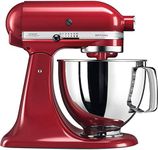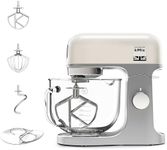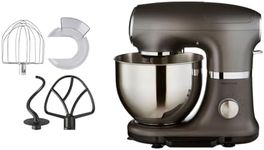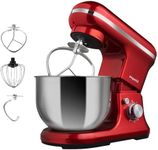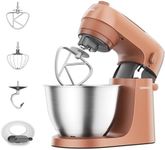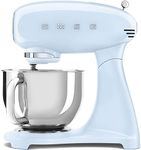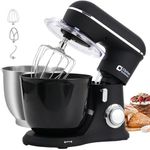Buying Guide for the Best Stand Mixers
Choosing the right stand mixer can make a big difference in your kitchen, whether you're a casual baker or a serious chef. Stand mixers are versatile appliances that can help you with a variety of tasks, from mixing dough to whipping cream. To find the best fit for you, it's important to understand the key specifications and how they align with your needs. Here are some important factors to consider when selecting a stand mixer.Power/WattagePower, measured in watts, indicates the strength of the motor in the stand mixer. Higher wattage means the mixer can handle tougher tasks like kneading dense doughs or mixing large batches. For light tasks like whipping cream or mixing cake batter, a mixer with lower wattage (200-400 watts) is sufficient. For more demanding tasks, look for mixers with higher wattage (500-1000 watts). Consider what types of recipes you plan to make most often to determine the appropriate power level for your needs.
CapacityCapacity refers to the size of the mixing bowl, usually measured in quarts. A larger capacity bowl (5-7 quarts) is ideal for big batches or heavy-duty baking, while a smaller bowl (3-4 quarts) is suitable for everyday use and smaller recipes. Think about the quantity of food you typically prepare and choose a bowl size that matches your cooking habits. If you often bake for large groups or make multiple batches, a larger capacity will be more convenient.
Speed SettingsSpeed settings allow you to control the mixer’s speed for different tasks. More speed options provide greater flexibility, enabling you to mix ingredients at the appropriate pace. Basic mixers may have 3-5 speeds, while more advanced models can offer up to 12 speeds. If you need precision for various recipes, opt for a mixer with more speed settings. For general use, fewer speeds may suffice.
AttachmentsAttachments expand the functionality of your stand mixer. Common attachments include dough hooks, whisks, and paddle beaters. Some mixers also offer additional attachments like pasta makers, meat grinders, and vegetable spiralizers. Consider what types of tasks you want to perform with your mixer and choose a model that includes or is compatible with the necessary attachments. If you enjoy experimenting with different recipes, a mixer with a wide range of attachments will be beneficial.
Build QualityBuild quality refers to the materials and construction of the stand mixer. Mixers made from durable materials like metal are more robust and long-lasting compared to those made from plastic. A sturdy build ensures stability during operation, especially at high speeds or with heavy doughs. If you plan to use your mixer frequently, investing in a model with high build quality will provide better performance and longevity.
Ease of CleaningEase of cleaning is an important consideration, as mixers can get messy during use. Look for models with dishwasher-safe attachments and bowls, as well as smooth surfaces that are easy to wipe down. Some mixers have features like tilt-head designs that make it easier to access the bowl and attachments for cleaning. If you prefer minimal maintenance, choose a mixer that is designed for easy cleaning.
Size and WeightSize and weight are important if you have limited counter space or plan to move the mixer frequently. Larger, heavier mixers are more stable but can be cumbersome to move. Compact, lightweight models are easier to store and transport but may not be as powerful. Consider your kitchen space and how often you’ll need to move the mixer when choosing the right size and weight for your needs.
